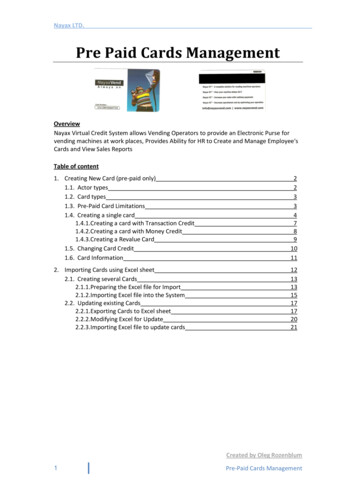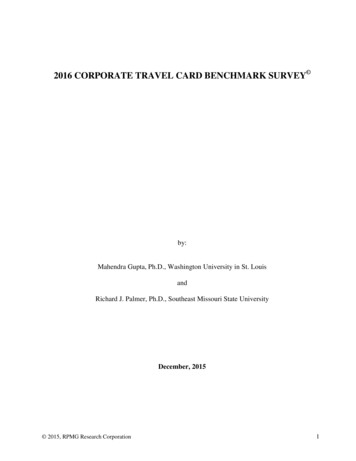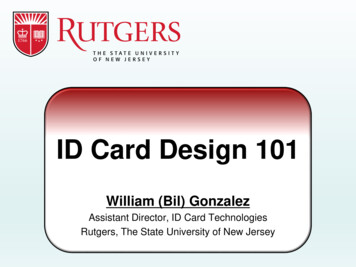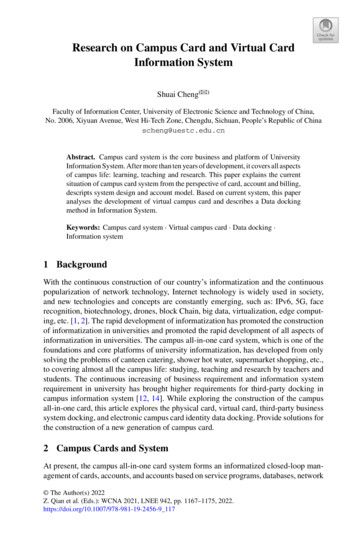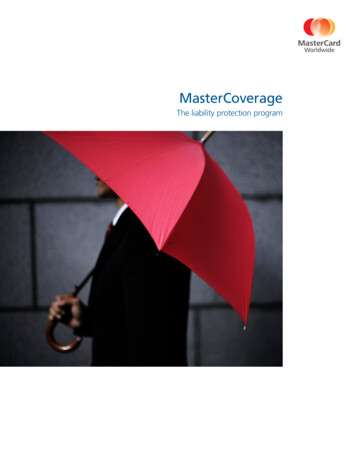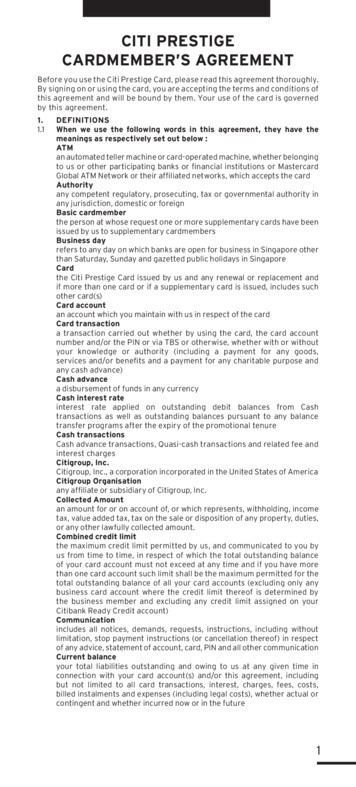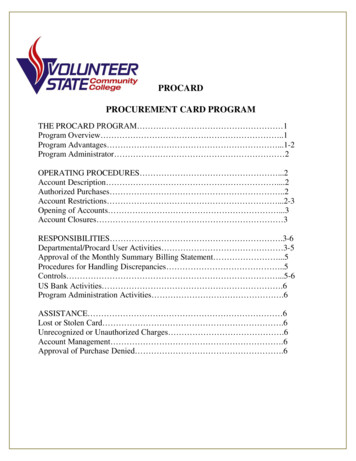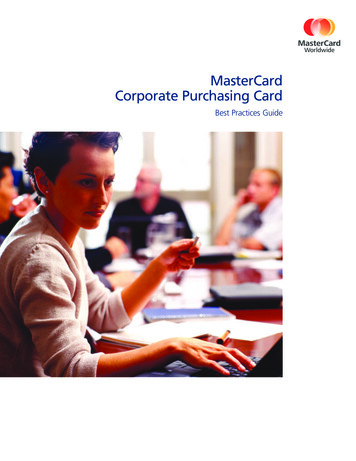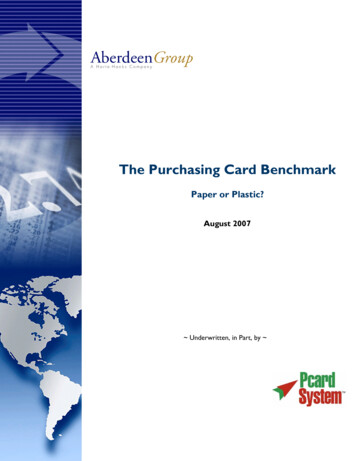
Transcription
The Purchasing Card BenchmarkPaper or Plastic?August 2007 Underwritten, in Part, by
The Purchasing Card BenchmarkPage 2Executive SummaryPurchasing Cards, commonly called “P-cards,” were designed to streamline both endsof the procure-to-pay process while introducing greater levels of control and visibilityto the management of low-dollar, high-volume categories. More than a decade later,enterprises, on average, place 8% of their indirect spend on P-cards, while Best inClass programs significantly outpace their peers and place, on average 22% of theirindirect spend on P-cards.Best in Class PerformanceAberdeen evaluated 297 enterprises between March and July 2007 and distinguishedBest in Class enterprises by two key measures: (1) percentage of indirect spendplaced on P-cards and (2) percentage of suppliers who accept P-cards. Best in Classenterprises in this study are notable for their superior performance and theirfollowing advantages: “Paying via P-card versuson invoice saves usapproximately 18 forevery transaction that isprocessed.”- Purchasing CardManager, Fortune 100companyAttribute a 64% greater savings benefit from their P-card programUse P-cards to settle 2.8 times higher percentage of transactions22% greater category coverageCompetitive Maturity AssessmentSurvey results show that the firms enjoying Best in Class performance shared severalcommon characteristics including Superior invoice visibility (i.e. Level 3 data) (68%); formal program expansioninitiatives (51%); higher levels of automation to improve P-card managementand administration (84% more likely use of a fully automated solution and 93%more likely to integrate their cards with their eProcurement system); andhigher average program limits (above 7,000)Required ActionsTo achieve Best in Class performance, enterprises must: Seek to energize their programs with clearly defined policies, newlyempowered administrators, and an aggressive plan to grow the program bytargeting new categories and/or suppliers Improve P-card data and workflow integration with e-procurement and othersystems of record to align the card program with procurement and financeFigure 1: Transaction Processing CostsP-cardManual 36.80 12.60P-card 2007 Aberdeen Group, Inc.www.aberdeen.comManualSource: AberdeenGroup, August 2007Telephone: 617 723 7890
The Purchasing Card BenchmarkPage 3Table of ContentsExecutive Summary.2Best in Class Performance .2Competitive Maturity Assessment.2Required Actions .2Chapter One: Benchmarking the Best in Class.4Reasons for Implementing P-card Programs and Current Challenges .4Maturity Class Framework .5Best in Class PACE Model .6Chapter Two: Benchmarking Requirements for Success .8Competitive Assessment. 9 Toc176319709Usage of Technology to Enable Efficiency of P-card Program .9Key Performance Metrics . 11Chapter Three: Required Actions . 13Laggard Steps to Success. 13Industry Average Steps to Success. 13Best in Class Steps to Success . 14Appendix A: Research Methodology. 16Appendix B: Related Aberdeen Research. 18Featured Underwriters. 19FiguresFigure 1: Transaction Processing Costs.2Figure 2: Length of Time P-card Program Has Been in Place.4Figure 3: Importance Rankings for Implementing a P-card Program .4Figure 4: Challenges Faced with P-card Programs .5Figure 5: Maximum Limit Ranges.8Figure 6: Methods of Payments (by total value).8Figure 7: Administration and Management of P-cards. 10Figure 8: Transaction Processing Costs. 11TablesTable 1: Companies With Top Performance Earn Best in Class Status: .6Table 2: PACE Framework .7Table 3: Competitive Framework .9Table 4: Average Number of Transactions and Spend via P-card . 11Table 5: PACE Framework . 17Table 6: Maturity Framework. 17Table 7: Relationship between PACE and Competitive Framework. 17 2007 Aberdeen Group, Inc.www.aberdeen.comTelephone: 617 723 7890
The Purchasing Card BenchmarkPage 4IChapter One:Benchmarking the Best in Classn an era where alternative payment methods can help enterprises cut through thecloudy haze of low visibility and increase process efficiency, purchasing cards (Pcards) have emerged as an effective method to revamp the processing oftransactions and realize the silver lining of significant cost savings. Aberdeen researchhas found that enterprises are at varying levels of maturity with their P-card programs.Only 4% of the 297 respondents reported not currently having a program in place.As shown in Figure 2, the majority of enterprises (70%) have had a P-card program inplace for more than three years,ample time to not only solidify Figure 2: Length of Time P-card Programtheir grip on process bearings but Has Been in Placealso realize the many benefits thatDon’t have one,come from using this type ofLess than 14%alternative payment methods.year, 11%More than 10Interestingly, 61% of the Best inyears, 13%1 to 2 years,Class enterprises have had P-card12%programs for more than 6 years,compared to 44% of others.Reasons for ImplementingP-card Programs andChallenges CurrentlyFaced6 to 10 years,34%Fast Facts Key actions Best In Classenterprises reported:- Increase amount ofspend through P-card(51%)- Improve data andprocess integration(43%)- Encourage greaterusage of ghost P-cardaccounts withpreferred suppliers, keybuyers/spendcategories (41%)3 to 5 years,26%Survey respondents revealed arange of reasons for initiallySource: AberdeenGroup, August 2007implementingtheirP-cardprograms. Figure 3 shows the importance of various factors in driving the decision toimplement a P-card program.Figure 3: Importance Rankings for Implementing a P-card Program4.23Process and transaction cost savingsProvide reporting data3.99Employee productivity and convenience3.973.78Supplier acceptance and ease of use3.66Expenditure cost savingsImproved visibility into cash flow3.46Maximize rebate or incentives3.4001Not Important2345Extremely ImportantSource: AberdeenGroup, August 2007The enterprises represented in our survey indicated that process and transactioncost savings (4.23 score) were the main driver for implementing a P-card program 2007 Aberdeen Group, Inc.www.aberdeen.comTelephone: 617 723 7890
The Purchasing Card BenchmarkPage 5within their organization. By using manual and paper-based methods of payment,enterprises are stuck in a process that is overburdened with labor-intensive activityand high transaction costs. Chapter 2 details how P-card programs offer the relief oflowering these costs.The second major driver is having access to data for reporting purposes aroundpurchasing (3.99 score). Visibility into spend is all-too-often crucial to an enterpriselooking to reap cost savings and gain intelligence at a higher level. Data collected fromthe use of P-cards can vary from Level 1 (i.e., date of the transaction, the suppliername, and the amount of the purchase) to Level 3, which is the richest data set (i.e.,product code, sales tax, freight/duty amount, and product service/description).Figure 4: Challenges Faced with P-card ProgramsCard administration, managing exceptions andpayment approvals48%Need for level 2 or level 3 to support sourcingstrategies38%Employee support for program32%Lack of supplier acceptance of P-card30%Middle management support for program30%Executive support for grow th of the programVolume shifting to other payment options (ACH, EFT,E-Invoicing)“Our major challenge isaround receiving Level 2and Level 3 data; very fewsuppliers offer it.”- Large manufacturingcompany27%24%Source: AberdeenGroup, August 2007It is fairly clear from the chart above that even though enterprises are largely maturein their usage of P-card programs, 48% of them still face challenges with cardadministration, management of exceptions and approval processes.Traditionally, enterprises have not used automated solutions to help manageprocesses and administration aspects for P-card programs (similar concept to expensemanagement solutions that help to manage corporate cards).Thirty eight percent of respondents face challenges in receiving Level 2 or Level 3data from suppliers to support their sourcing strategies. The data that P-card cancollect is valuable in helping understand where there may be opportunities forextracting savings.Maturity Class FrameworkTop-performing (Best in Class) enterprises have generated significant cost savings andincreased visibility into their spend as a direct result of utilizing a P-card paymentprogram. Aberdeen used two metrics to determine Best in Class: the percentage ofspend processed through P-cards and the percentage of suppliers paid via Pcard. Table 1 summarizes the findings and defines Best in Class performance for ourPurchasing Cards benchmark study. 2007 Aberdeen Group, Inc.www.aberdeen.comTelephone: 617 723 7890
The Purchasing Card BenchmarkPage 6Table 1: Companies With Top Performance Earn Best in Class Status:Definition of Maturity ClassMean Class PerformanceBest in Class: Top 20% of aggregateperformance scorers 22% of total spend through P-card29% of suppliers paid via P-cardIndustry Average: Middle 50% ofaggregate performance scorers 11% of total spend through P-card19% of suppliers paid via P-cardLaggard: Bottom 30% of aggregateperformance scorers 6% of total spend through P-card11% of suppliers paid via P-cardSource: AberdeenGroup, August 2007In Chapter Two, our research will show both the immediate and long-term results ofthe Best in Class methods associated with purchasing card programs, including lowertransaction-processing costs and increased visibility into enterprise spend.Case Study – University of California at San DiegoUC San Diego has had a purchasing card program for about 12 years and has experiencedsignificant growth over the last couple of years (25% per year). The spend for last year wasapproximately 24 million, with 1300 card users some of which have more than one card. It isanticipated that this year's spend will be 33 million. Susan Maciel, the P-card Program Managersaid she spends 75% of her time managing the program with a full time auditor and a cardadministrator.In order to promote usage of P-cards, UCSD raised the single transaction limit from 2,500 to 4,999, with a monthly spend of 10,000. This includes some items that previously needed preapprovals. Additionally, according to Susan, "In order to promote usage we use a quarterlynewsletter to update cardholders about program changes as well as an information portal whichallow us to display card usage tips and best practices, etc.""Last year, the program had 77,000 transactions, this is likely to grow by at least 30%. Inaddition spend will increase another 2 million due to the implementation of an e-Procurementsystem at the end of this year", said Susan. "P-card spend with certain vendors will growtremendously via the e-Procurement system."Best in Class PACE ModelUsing an effective P-card program to garner cost savings and produce higher visibilityinto spend requires a combination of strategic actions, organizational capabilities andenabling technology that can be summarized as follows: 2007 Aberdeen Group, Inc.www.aberdeen.comTelephone: 617 723 7890
The Purchasing Card BenchmarkPage 7Table 2: PACE FrameworkPressures Pressure toreduce processingand transactioncostsActions Increase amountof spend throughP-card Improve P-carddata integrationwith GL or ERPsystem Greater use ofghost P-cardaccounts withpreferredsuppliers, keybuyers/spendcategories Eliminate thepaper insubmission,approval and auditprocessing Improve P-carddata integrationwith eprocurementCapabilities Ability to createcustomized reports Access to currentand archivedstatements Line item detailfrom transactions Integration withG/L and othertransaction systemsEnablers Automatedpayment methods Central system tomanage andapprovetransactions Access to Level 3data Reporting andanalysis tools ApprovalworkflowSource: AberdeenGroup, August 2007Aberdeen Insights – Category StrategyAberdeen research identifies the top categories purchased on P-cards today include: Office supplies and equipment MRO supplies Computer equipment and peripherals Printing services Education suppliesBest in Class enterprises are rethinking the traditional paradigm a majority have invested inexpanding their programs, they report broader coverage in terms of the categories of spend that arepart of their P-card programs. Categories which include: IT - Software IT- Hardware Package/parcel shipping Raw materialsA smaller percentage of the Best in Class are capturing services categories like: employee benefits,temporary labor and consulting services, as well as IT services and their successes in these areasmake a strong case for others. 2007 Aberdeen Group, Inc.www.aberdeen.comTelephone: 617 723 7890
The Purchasing Card BenchmarkPage 8Chapter Two:Benchmarking Requirements for SuccessPurchasing cards as a whole still do not represent the major portion ofpayment methods. Traditionally, P-cards have been used for good/servicesunder 1,000, however, as shown below in Figure 5, this maximum limit ismoving towards a higher range so as to include larger ticket items. A higherpercentage (35%) of Best in Class companies have a maximum limit on their Pcard of over 10,000 (approximately half of these enterprises reported amaximum limit of 40,000 to 50,000).Figure 5: Maximum Limit RangesAll OthersBest in Class26%25%23%Fast Facts Card-able spend for the Bestin Class is 22% Best in Class have higheraverage program limits (31%) Best in Class use P-cards for28% of their payments35%25%21%16%13%13%4%Less than 1,000 1,000 to 2,500 2,501 to 5,000 5,001 to 10,000More than 10,000Source: AberdeenGroup, August 2007How do enterprises make their payments? According to our research, a large portionof payments are still made by check, which is also the most expensive method.However, other methods utilized include Electronic Fund Transfers (EFT) andAutomated Clearing House (ACH). Our research shows that Best in Class enterprisesuse P-cards for almost 30% of all payments, compared to 10% of all other enterprises.Figure 6: Methods of Payments (by total value)Best in Card8%OtherSource: AberdeenGroup, August 2007 2007 Aberdeen Group, Inc.www.aberdeen.comTelephone: 617 723 7890
The Purchasing Card BenchmarkPage 9Competitive AssessmentThe aggregated performance of surveyed companies determined whether they rankedas Best-in-Class, Industry Average or Laggard. In addition to having commonperformance levels, each class also shared characteristics in five key categories: (1)process (methods of payment used, approvals, etc); (2) organization (responsibilityand oversight of program (3) knowledge (access to spend data and level of detail); (4)technology (selection or appropriate tools and intelligent deployment of those tools);and (5) performance management (ability of the organization to measure the benefitsof a program and use the results to improve key processes further).“By enabling ghost cards tobe used on our new eprocurement system, weforesee the programgrowing by at least 10%.”- Procurement Director,Educational InstitutionTable 3: Competitive FrameworkProcessOrganizationalStructureKnowledge andDataLaggardsAveragePercentage of payments made via P-card8%Best in Class14%28%22%41%Dedicated program administrator10%Receive Level 3 data41%54%68%Importance of easy access to current and archived statements53%63%76%Fully automated process for managing P-card transactions8%17%23%Percent of spend through P-cardPerformanceMetrics6%11%22%Percent of payments made via P-card on an e-procurement system9%18%26%Source: AberdeenGroup, August 2007“Ghost cards” are P-cards typically designated for use by a single department or witha single supplier, and usually have large spending limits and allow purchasing cardprogram managers to track and reconcile activity on the account without puttingplastic in the hands of every buyer in the organization.Usage of Technology to Enable Efficiency of P-card ProgramAs noted previously, one of the major challenges faced by enterprises is the overalladministration and management of the P-card program. In our effort to betterunderstand the ways in which enterprises are accomplishing this currently, weuncovered a high percentage of manual and/or semi-automated processes. Figure 7below shows the methods currently used by enterprises, as well as their plans overthe next 12 months. Approximately a quarter of the respondents currently usemanual processes for the administration of P-card transactions and another 30% usesomewhat automated solutions provided by their bank or issuer. However, over the 2007 Aberdeen Group, Inc.www.aberdeen.comTelephone: 617 723 7890
The Purchasing Card BenchmarkPage 10next year, 47% reported plans to use fully automated solutions (28% looking to theirbanks/issuer and 19% looking to a third-party solution).Figure 7: Administration and Management of P-cardsCurrently UsePlan to Use w ithin 12 %8.9%3.9% 3.8%No formalmethod orprocessFullyautomatedthird partysolutionOtherFullyautomatedsolution frombank/issuerManuallySemiautomatedsolution f rombank/issuerSource: AberdeenGroup, August 2007Case Study – Large Construction and Engineering EnterpriseAccording to the P-card Administrator of a 3 billion dollar enterprise, its P-card program averages70,000 transactions per year, totaling approximately 17 million. Transaction limits are generally setat 2,500, however, the monthly maximum is 15,000.“When I first joined the company, we had over 100 billing accounts, making management andadministration extremely difficult, this has since dropped to 17,” said the P-Card Administrator,adding, “One of my major challenges today is that I am faced with using three different systems(provided by our bank/issuer) - one to view statements, another for online administration and a thirdfor reconciliation; the worst part is that they are not connected.” To perform the necessary level ofanalysis, the P-Card Administrator must download custom reports from the three systems into anAccess database that she created and perform her analysis outside of the actual card system.Her team’s analysis of different internal transaction processing costs found the following: P-cards processing versus purchase order: P-cards save 157 min and 140 pertransaction. They looked at PO process in detail including, requisition, creating the PO,approval time, mailroom time, reconciliation, etc.P-cards processing versus direct invoicing: P-cards save 18 per transaction“I’m always looking for ways to increase program size. Often I run reports on invoices and POs tolook for opportunities where a P-card can add value; if I find something I contact those budgetholders and attempt to move them onto the P-card program,” the P-card Administrator. 2007 Aberdeen Group, Inc.www.aberdeen.comTelephone: 617 723 7890
The Purchasing Card BenchmarkPage 11Key Performance MetricsAs shown previously, our analysis has included Best in Class, Industry Averageand Laggard data, however, an important variable when considering P-cards isthe size of the company. In Table 4, we can see how the average number oftransactions and annual spend via P-card differs by company size, however, thedollar value has significantly increased compared to one year ago.Table 4: Average Number of Transactions and Spend via P-cardMid-Market26,098 4,182,000 5,262,907Average number of transactions per monthAverage annual spend via P-card - On year agoAverage annual spend via P-card - CurrentLarge85,214 8,270,492 9,767,905Source: AberdeenGroup, August 2007There is no doubt that a bulk of thesavings from utilizing P-cards come fromreduced transaction costs. This is largelydue to reduced time for expensereporting and invoice-processing, as wellas less time spent on ing.The next level of savings comes fromincreased visibility into company spend.When moving to more automatedtransaction-reporting and processing, anenterprise can significantly reduce“maverick” spend, eliminate unauthorizedpurchases by employees, and monitortransactions almost in real time.Figure 8: Transaction ProcessingCostsP-cardManual 36.80 12.60P-cardManualThe enriched data available from theseSource: AberdeenGroup, August 2007card transactions enables companies of allsizes to better monitor and identify spending patterns. At the same time, paymentcard programs make it easier to enforce employee compliance with enterprisepolicies. 2007 Aberdeen Group, Inc.www.aberdeen.comTelephone: 617 723 7890
The Purchasing Card BenchmarkPage 12Aberdeen Insights – From Maverick Spend Marvel to P2P PlayerPurchasing cards were originally established as an alternative to petty-cash and other small,generally manual, purchases. This legacy now presents a primary hurdle to the expansion of P-cardprograms today, and will require a new mindset for P-card program managers if they are to identifygreater percentages of “card-able” spend.Procure-to-Pay (P2P)With the rise and broad adoption of e-procurement technology, the procure-to-pay (P2P) processwithin most enterprises has become both more robust and more fluid. Usage of P-cards arose tostart capturing data for those “maverick” transactions that normally fell outside of the standard P2Pprocess. Today, procurement organizations the world over focus intently on the reduction of“maverick” spend - this, in many cases, is a drive to eliminate the kinds of transactions that P-cardswere developed to manage.Best in Class Strategy: IntegrationBest in Class enterprises take a different view and utilize P-cards across a far greater number ofcategories and attribute a large part of their successes to their ability to utilize standard requisitionto order processes for their card purchases and their ability to socialize P-card invoice data withtheir back-end system(s) of record. Additionally, the rise of Level 3 data capture in P-cardstatements, enables procurement department to identify more and better opportunities to aggregateP-card spend and negotiate superior savings because of improved leverage1 in card-able categories1Corporate Payment Cards: More Value, Higher Savings (August, 2006) 2007 Aberdeen Group, Inc.www.aberdeen.comTelephone: 617 723 7890
The Purchasing Card BenchmarkPage 13Chapter Three:Required ActionsWhether a company is trying to move its Purchasing Card program performance from“Laggard” to “Industry Average,” or “Industry Average” to “Best in Class,” thefollowing actions will help spur the necessary performance improvements:Laggard Steps to Success Designate a purchasing card program administrator and empowerthe position.Push control of your program down the organization and identify a managerwho can both administer the program as it exists today and energize itsexpansion. In a role that should be part sales (to build internal support foradoption and sell suppliers on the benefits) and part compliance (managinglimits and policies and adherence to them), an effective card administrator isone that is empowered to make policy decisions. 41% of Best in Classprograms have a P-card program administrator. Energize the program with the development of a new P-card policyand limit ways to bypass using the cards.Fast FactsThe Best in Class have ahigher percentage of cardable spend (22%) andsuperior savings rates(64% higher than theirpeers). They also . Understand the value ofdetailed (Level 3) invoicedata (68%) Offer greater programadministrative flexibility(68%) Take a deliberateapproach to programexpansion (51%)The average card program has been in place for more than three years andfaces program fatigue. To combat this problem, develop a new policy thatprovides more flexibility from an administrative management and oversightstandpoint (i.e the management of limits) but is more stringent in its usagepolicies. 68% of Best in Class programs offer greater administrative flexibility.Mandate card usage for defined categories and require a signed/emailed VPlevel approval for all off-card purchases made in these categories. Educate your internal stakeholders and suppliers via a formalexpansion program51% of the Best in Class programs have dedicated expansion programs thatfocus on expanding their programs beyond non-purchase order or ad hoctransactions via supplier outreach and internal education. Leverage your Pcard solution provider to provide assistance in the development of a seriesbest practices around the unique offerings of your program and develop anaggressive supplier outreach program that focuses on the primary valueproposition.Industry Average Steps to Success Seek greater invoice detail.Level 3 data is widely available in the marketplace and becoming a standardfeature in most P-card programs. In fact, 68% of Best in Class programsreceive Level 3 data. Acknowledge that there is an effort required on the partof your suppliers to provide this information and collaborate with them onthe most efficient ways to do so. Set aggressive growth targets to captureLevel 2 and Level 3 data across a broader percent of spend over the next 6 to 2007 Aberdeen Group, Inc.www.aberdeen.comTelephone: 617 723 7890
The Purchasing Card BenchmarkPage 1412 months and work with procurement to evaluate the benefits of the richerdata. Involve P-card administrators in strategic sourcing initiatives.The move to Best in Class will require a deliberate effort to expand thenumber of categories and the amount of spend within each category. P-cardadministrators can play a valuable role in the expansion of your card programby engaging sourcing teams at the outset of an initiative to help identifyexisting and new ‘card-able’ categories and ensure that any supplierrequirements are included in the RFP or bid process. P-card administratorscan also assist by introducing any card program requirements during thecontract negotiation.Case Study – Tucson, ArizonaBuilding upon the success of a small departmental card program, the procurementdepartment for the City of Tucson, Arizona began an initiative to identify a P-card programthat could extend similar benefits across the entire city.Following an extensive RFP process and a six-month pilot program, the P-card program wasrolled out to the entire city in early 2005. The rollout effort consumed significant time andresources and while major glitches were avoided, the program was not completely embracedand adoption lagged. To ensure broader adoption, the procurement department Established and enforced stricter usage guidelines for small purchase Reduced the times and days that petty cash reimbursements are available Worked with their sourcing professionals to ensure that the majority of RFPsacross any type of service/item include language to ensure that they will beincluded in the card programAllowed department heads to manage and set their group’s transaction limits“We doubled the amount of spend on our card in the second year of the program. We thinkthat we will double it again this year. And, with the savings we have seen to date, we do notanticipate curbing usage anytime soon. Our main challenge has been matching our staffingto the program growth,” said Brian P. Garrity, C.P.M., CPPB; Management CoordinatorDepartm
allow us to display card usage tips and best practices, etc." "Last year, the program had 77,000 transactions, this is likely to grow by at least 30%. In addition spend w ill increase another 2 million due to the implementation of an e-Procurement system at the end of this year", said Susan. "P-card spend with certain vendors will grow


